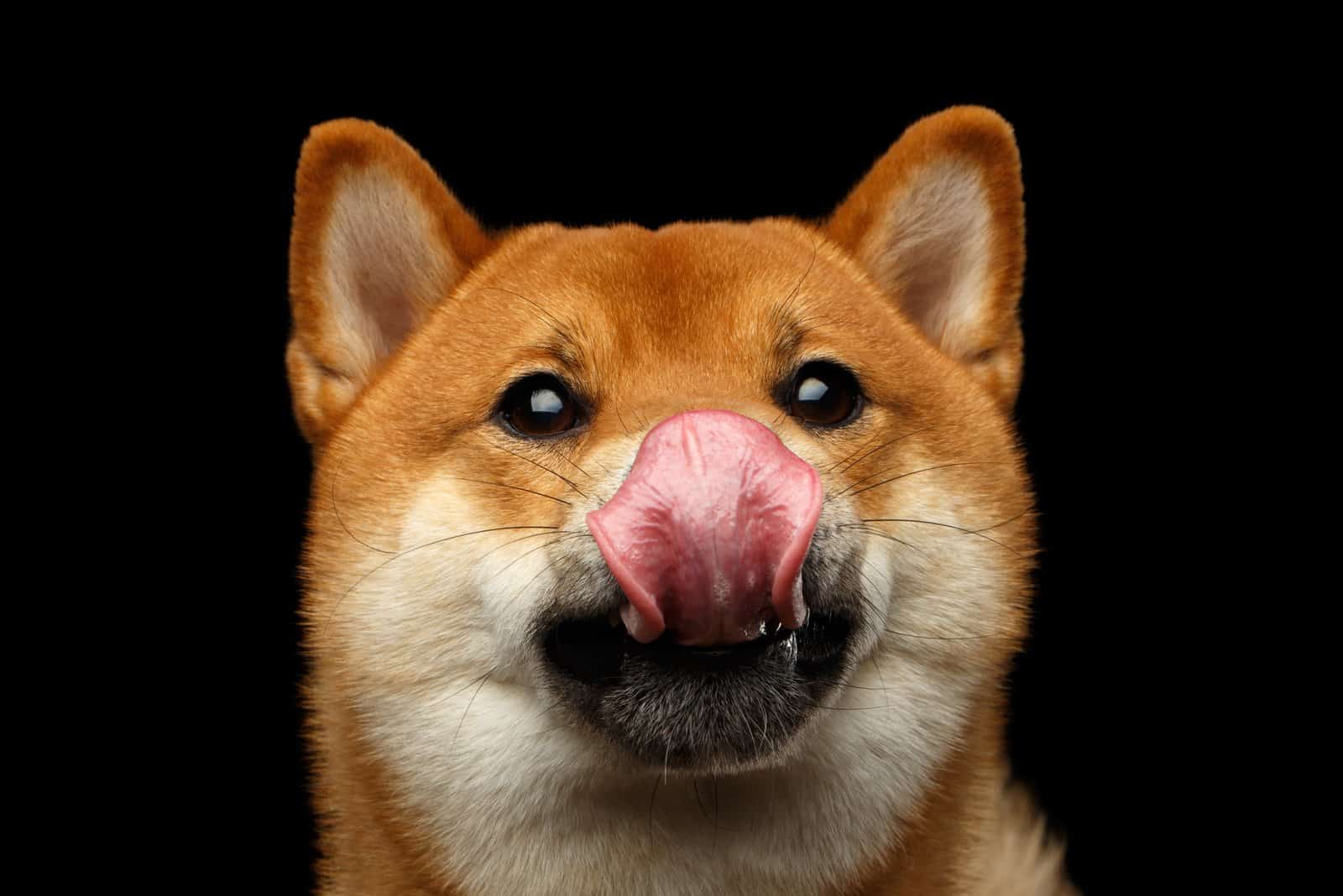Shiba Inu dogs originated in Japan and are well known all around the world for their unique appearance and their tendency to retain a puppy-like temperament, even in adulthood.
They are smart, agile, and undyingly loyal companions that make impressive watch dogs but also wonderful family members.
So, it shouldn’t come as a surprise to anyone that due to their popularity, tons of people are looking to buy Shiba Inu puppies – in fact, Shiba Inus are considered to be among the handful of dog breeds whose popularity never seems to decrease.
Whether you’re looking to buy a new Shiba Inu puppy, or you’ve already got one and you want to find out everything there is to know about being a good dog owner and how to properly feed your new pup – a Shiba Inu feeding chart is a practical tool that will help you to understand your new puppy’s feeding requirements.
It’s worth noting that every puppy needs a healthy amount of exercise and a healthy balanced diet in order to thrive and grow into a strong adult dog – and Shiba Inu dogs are no exception.
In fact, Shiba Inu are highly active dogs whose nutritional needs surpass the needs of your average Spaniel – due to their incredibly fast metabolism they are able to digest a meal quickly and become hungry again in a heartbeat.
So, whether you’ve got a tiny new Shiba Inu puppy or a young adult Shiba Inu that’s already grown up – we’ve got you covered with this Shiba Inu feeding chart, as well as some useful tips on how and when to feed your Shiba for optimal health results.
Shiba Inu Feeding Chart
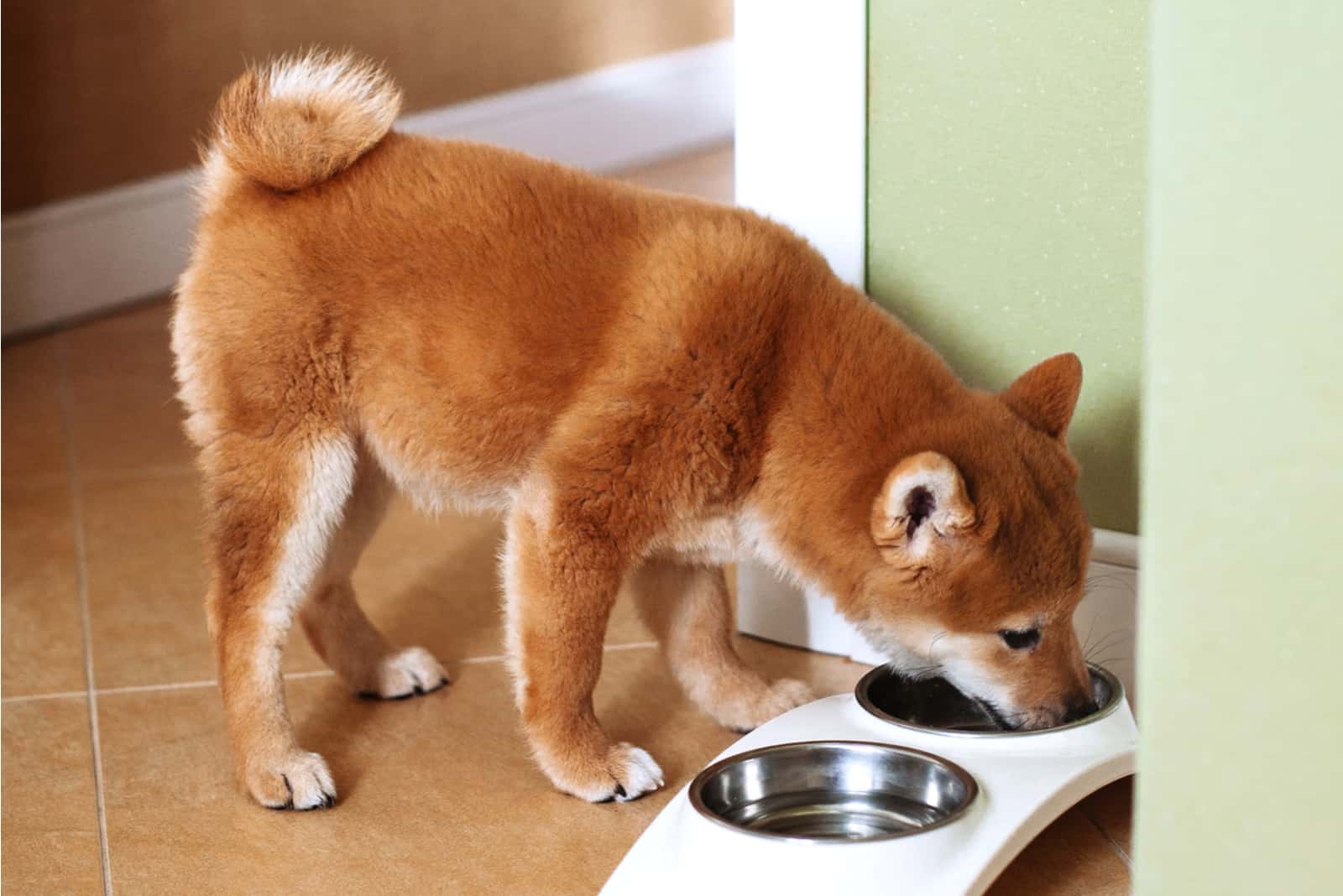
Although the Shiba Inu is the smallest of the native Japanese Spitz breeds, it’s not considered to be a small breed in comparison with other bigger dog breeds – the Shiba Inu falls into the medium-sized breed category.
Before we take an in-depth look into the specifics and break everything down, here’s a quick look at the Shiba Inu feeding chart according to age.
[table id=471 /]
It’s worth noting that there are lots of other things you need to take into consideration when feeding your Shiba Inu puppy, such as the age of your pup, its activity level, its weight, food allergies, etc. – but we’ll cover these later on.
Keep in mind that this Shiba Inu feeding chart is meant to serve as a guide for the average nutritional needs of the average Shiba puppy, and not as a must-follow instruction.
Don’t be too worried if you’ve been giving your pup more or less food than the Shiba Inu feeding chart, because each individual pup grows at its own rate and you can always adjust the number of servings and the amount of food you feed it accordingly.
It’s also worth mentioning that most experienced Shiba Inu owners say that Shiba Inus need a higher amount of calories than is suggested by most pet food manufacturers.
That said, if you want to potentially prolong your Shiba Inu’s lifespan, it’s best to do so with a balanced diet and frequent exercise, while also making sure that you take them to the vet for check ups regularly.
How Many Times A Day Should I Feed My Shiba Inu?
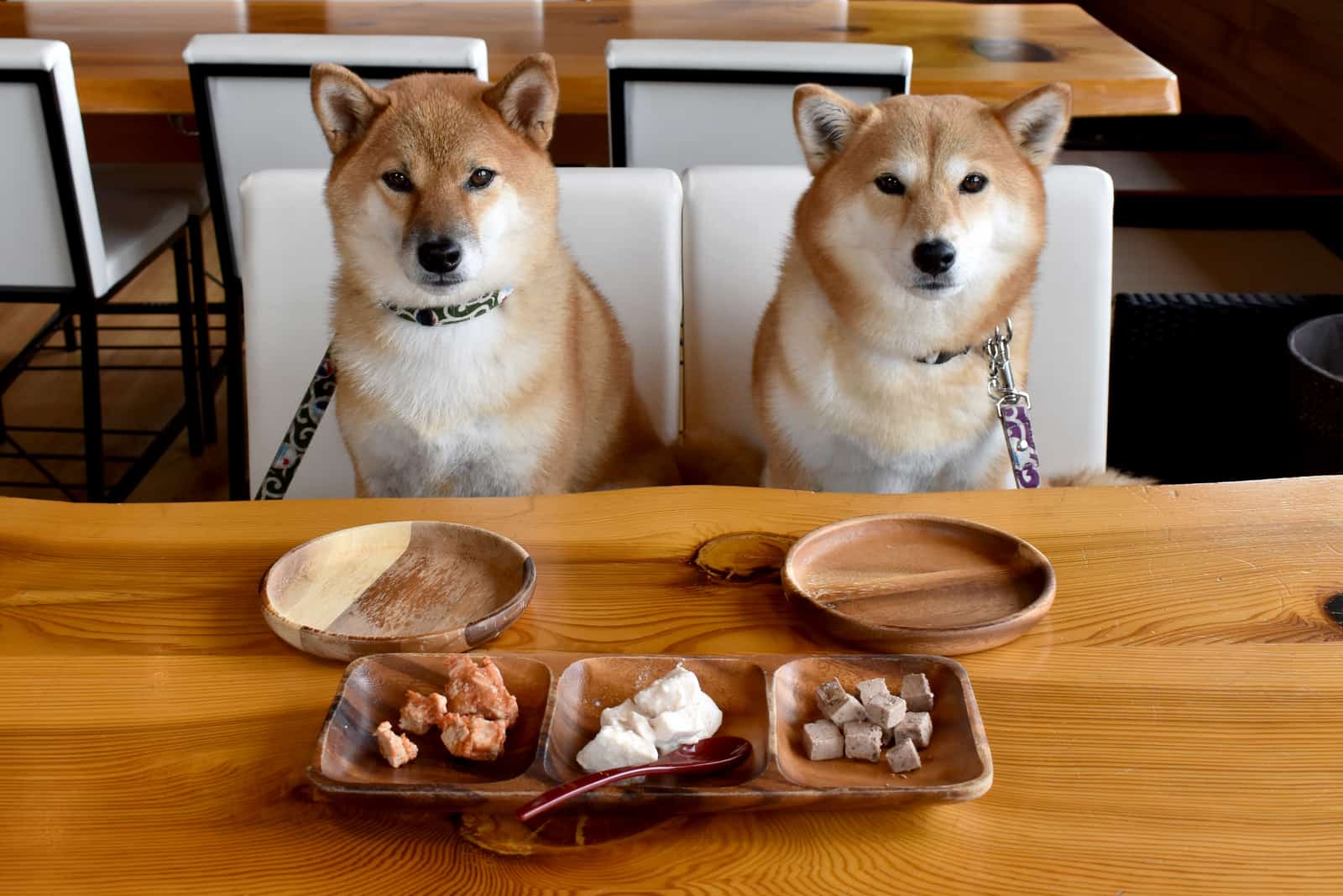
As a responsible Shiba Inu owner, you should utilize the information from the Shiba Inu feeding chart in combination with a licensed veterinarian’s opinion in order to create a daily feeding schedule for your Shiba Inu.
After you’ve determined exactly how much food you’ll feed your pup daily in accordance with its age, weight, and activity level – it’s time to come up with a plan on how many times a day you should feed your dog.
Young Shiba Inu puppies, from the ages of six weeks to twelve weeks, should eat four meals per day, pups from the age of twelve weeks old to a year old should eat three meals per day, and adult Shiba Inu dogs over the age of one should ideally eat two meals per day.
Here’s a look at the number of meals that both male and female Shiba Inus should be fed daily, with respect to their age, represented in chart form.
[table id=472 /]
Most dogs function at their best when they have a daily routine – and Shiba Inus are no exception.
Ideally, you should feed your Shiba Inu at the same time each day in order to establish a routine with which your Shiba puppy will become comfortable.
Having said that, it’s important to be cautious when feeding your Shiba puppy – just like any other dog breed, Shiba Inu pups are barely able to control themselves when they’re around food of any kind.
Shiba Inu Overeating
It should be fairly obvious that if you leave your Shiba puppy unsupervised near an open bag of dog food, they’ll likely end up downing the entire bag until they feel sick to their stomach.
This is true for all dogs no matter the breed or gender, and it’s due to the fact that their ancestors were used to only eating on occasions when they managed to catch prey – therefore they would end up devouring as much as they could in order to survive as long as possible.
Due to this ingrained instinct to eat as much food as they can as quickly as possible, all puppies tend to overeat if they’re not supervised – which could lead to them becoming overweight.
That’s why it’s important to always monitor your Shiba puppy’s food intake and feed them the right amount of quality dog food so that they can maintain a healthy weight.
One more thing that you need to keep in mind, is that most pups don’t need the same amount of dry kibble as opposed to wet food.
How Much Food Should I Feed My Shiba Inu?
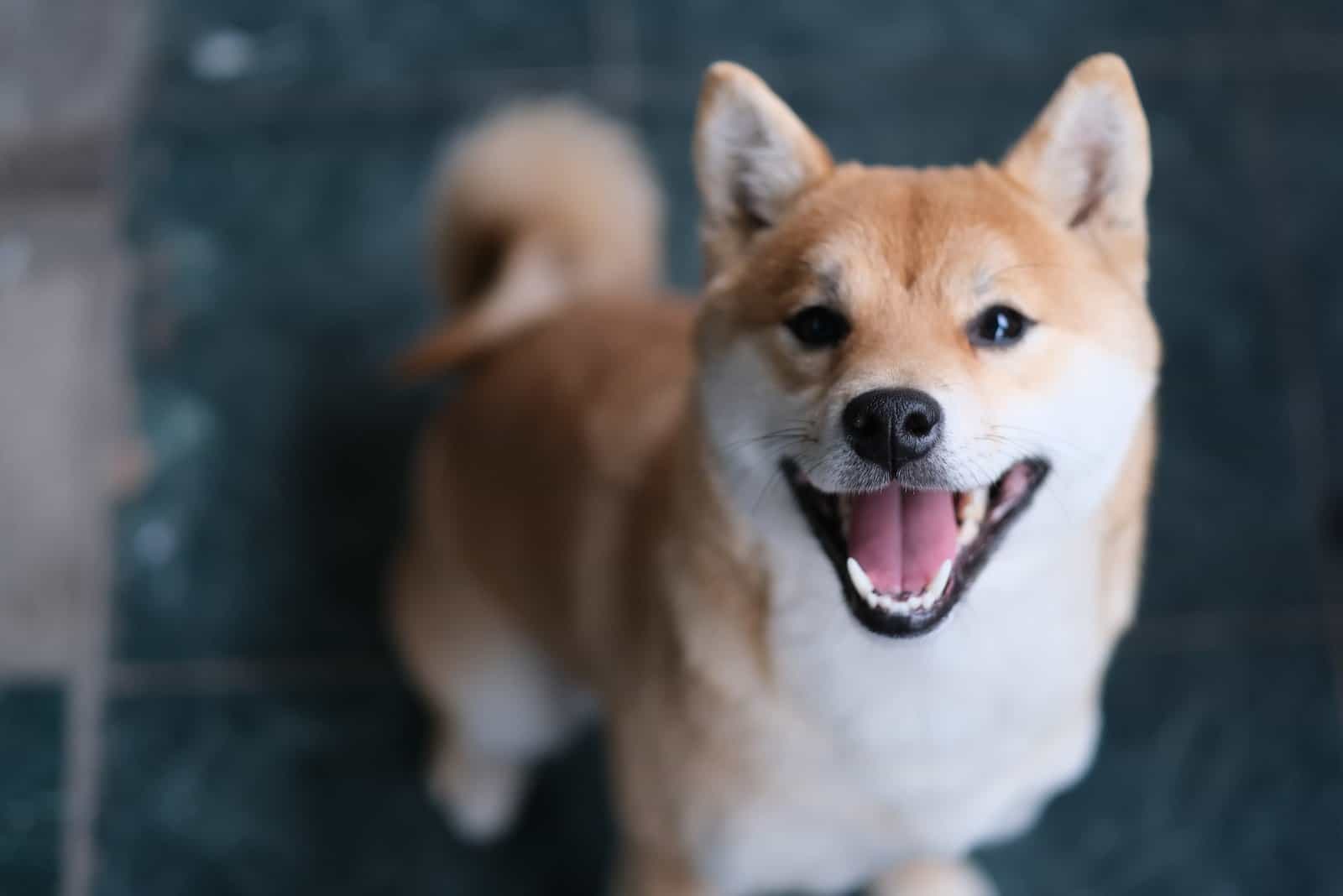
Now that we’ve given you a quick look at the Shiba Inu feeding chart, which you can follow to make sure you feed your new Shiba puppy the correct amount, it’s time for a more in-depth discussion – just to make everything you need to know crystal clear.
Here’s how much you should feed a Shiba Inu puppy according to its age.
Two Week Old Shiba Inu Puppy – The Neonatal Period
When a puppy is born they are completely reliant on their mother for warmth, nourishment, and safety – this is true for all puppies of all breeds. The only food a newborn puppy consumes during the first several weeks of their life is their mother’s milk, which contains all the necessary nutrients required for their survival.
At this stage of puppyhood, your tiny Shiba Inu puppy will begin to open their eyes for the first time but they still won’t be able to walk on their own or regulate their own body temperature – that’s why it’s crucial for them to stay near their mother.
There’s no reason to interfere with your puppy’s feeding at this time unless they’re not feeding properly or the mother is reluctant to let them feed on her milk – in that case, you should get a dog formula to feed your newborn pup in order to help them develop properly and gradually gain weight healthily.
If you suspect that something else is wrong with your puppy during this crucial stage of puppyhood, it’s best to consult with a veterinarian.
Three Week Old Shiba Inu Puppy
At the three-week mark, your Shiba puppy will start to be a bit more active but will still spend the majority of their time by their mother’s side.
Of course, your puppy will still be heavily dependent on their mother’s milk for nourishment, and they should instinctively feed on their own when they feel the need to do so.
Again, the only reason you should interfere at this stage is the same as in the previous stage – if your pup’s not feeding properly, use a dog formula to help nourish them.
Four Week Old Shiba Inu Puppy
At four weeks old, your Shiba puppy will start to explore their surroundings and begin playing with their littermates.
The four-week mark is the time when you should slowly begin to introduce your Shiba puppy to their first puppy food – even though their main source of nourishment should still come from their mother’s milk.
The best way to do this is to start giving your Shiba puppy tiny portions of puppy food to see if they’re even interested in trying it – it’s best not to force a puppy to eat the puppy food but to just place it under their nose and see what happens.
It’s important to note that a puppy this young still doesn’t have a digestive system that’s properly developed, so you should try giving them a small amount of puppy food mixed with water in order for them to be able to digest it.
The ratio of dry puppy food to water should be kept at one-quarter dry kibble to three-quarters of water.
Five Week Old Shiba Inu Puppy
A five-week-old Shiba puppy should be a bit more interested in the puppy food and water mix – even if they weren’t into it before, they should want to try it now.
However, it’s still important to keep the mixture at the same ratio because the puppy’s stomach is still very small, and their digestive system is still developing.
Shiba puppies that are five weeks old still need to consume their mother’s milk, albeit not as much as before, while slowly making the transition to puppy food.
At this stage, the puppy’s mother will instinctively start to wean them off her milk, but it’s important not to force your puppy to do so if they don’t feel ready for it yet.
Six Week Old Shiba Inu Puppy
A six-week-old Shiba puppy will slowly cease to drink its mother’s milk entirely and begin to consume puppy food as their main source of nourishment.
Your Shiba puppy will also start to gain more confidence and explore their surroundings even more – so the amount of energy their mother’s milk used to provide will no longer be sufficient for them.
When your Shiba Inu is used to eating the quarter puppy food to three-quarters water mix, you can start to increase the amount of food, decrease the amount of water, and make a fifty-fifty mix.
The best way to do this is to slowly add more puppy food to the same amount of water and gradually increase the amount of food until you end up with a half-and-half mix.
If your Shiba puppy is able to handle this mixture and you determine they’re ready for the next step – you can start giving them a mixture of ten percent water and ninety percent puppy food.
Seven Week Old Shiba Inu Puppy
A seven-week-old Shiba Inu puppy should exhibit a healthy appetite and enjoy their food even more than before – they should be able to eat dry dog food without any water with it.
Due to this abrupt change in their appetite, it’s important not to overfeed your Shiba Inu puppy at this stage – ideally, you should feed them small amounts of dry kibble spread out over four meals per day.
However, don’t be surprised if your Shiba puppy still needs a bit of their mother’s milk from time to time – this is usually the last stage of a puppy still feeding on its mother’s milk, and it’s also the time when their first puppy teeth will start to come in.
Eight to Nine Week Old Shiba Inu Puppy
An eight to nine-week-old Shiba Inu puppy should switch entirely to eating only puppy food and no longer be dependent on their mother for sustenance.
The eight-week mark is also the time when most responsible breeders allow their puppies to be adopted, due to their newfound independence – during this time it’s the new owner’s responsibility to control what their puppy eats and how much they eat.
As soon as you bring your new Shiba puppy home, it’s crucial to implement a rigid feeding schedule so that they can become accustomed to it as soon as possible.
A nine-week-old Shiba Inu puppy should be given around half a cup to one cup of puppy food at the same intervals as before, four times a day.
Because your Shiba puppy will be eating a lot of dry dog food, it’s also important that they have easy access to separate drinking water – so that their digestive system is able to handle it.
Ten Week Old Shiba Inu Puppy
A ten-week-old Shiba puppy’s energy levels and activity levels will most likely be through the woof – so it’s crucial to maintain their feeding schedule, while slowly adding half a cup of dry dog food into each meal.
This is also the period when your Shiba Inu will hit their first big growth spurt, so it’s important to keep an eye on their weight – Shiba Inus are prone to overeating, just like any other dog breed, which can lead to obesity if not kept in check.
You should still feed your Shiba puppy four meals a day, while the amount of food you give them should be between one and one and a half cups of puppy food – the ideal weight of a ten-week-old Shiba Inu puppy is anywhere between seven and eleven pounds.
Eleven to Twelve Week Old Shiba Inu Puppy
This is the time period when your Shiba Inu puppy’s appetite will seem never ending, since they’re right in the middle of their first real growth spurt – you should give your pup at least half a cup of food more in order to keep up with their development.
One thing to keep in mind during this stage is that your Shiba will most likely begin to chew on anything within paw’s reach because they will start teething.
It’s important never to leave your Shiba puppy unattended, since they could ingest something inedible that could cause potential health problems.
The best way to divert your Shiba puppy’s energy from chewing up your belongings is to invest in some durable dog toys.
Three to Six Month Old Shiba Inu Puppy
The three to six-month period is when your Shiba Inu puppy will grow the most – due to their higher energy levels, their appetite will also increase.
Make sure that you maintain your Shiba puppy’s feeding schedule, while slowly adding at least half a cup of puppy food spread out into their four daily servings.
A six-month-old Shiba Inu puppy should have a healthy weight between twelve and seventeen pounds.
You should also keep an eye on your pup’s stomach to make sure that it’s not bloating.
If your dog ingests something inedible, this might cause it to develop a condition known as gastric dilatation-volvulus – while this condition is rarely seen in young pups, it’s best to keep an eye out for it, just in case.
Six to Twelve Month Old Shiba Inu Puppy
From the six to twelve-month period of your Shiba puppy’s life, it’s safe to start feeding them up to two and a half cups of dry dog food spread out over three meals per day.
Your Shiba Inu puppy’s growth rate should visibly slow down at this point, while they will still continue to put on more healthy weight.
After your Shiba Inu puppy’s first birthday, it’s safe to start switching their diet from puppy food to real adult dog food.
The easiest way to do this is to slowly mix in tiny amounts of adult dog food into their puppy food and to continue doing so gradually until your Shiba Inu is eating the adult dog food with ease.
A one-year-old Shiba Inu dog should eat between two and two and a half cups of adult dog food, spread out over two meals a day, and they should weigh anywhere between seventeen and twenty three pounds.
Shiba Inu Puppy Food Nutritional Value
Another thing to keep in mind, in addition to the amount of food you feed your Shiba Inu, is the type of food you’re feeding them.
Compared to an adult Shiba Inu and young adult Shiba Inus, Shiba Inu puppies have different nutritional requirements due to their developing bodies, so they should be fed higher-quality foods.
Protein
Our best friends thrive best on a diet with a high protein content, unlike us humans, who mostly need carbs and sugar for our energy.
Growing Shiba Inu puppies should be fed a quality puppy food that has a protein content of at least twenty two percent – this should also be the first ingredient listed on the packaging.
It’s best to invest in high-quality dog food that contains natural protein sources, such as chicken, beef, and fish – and to avoid any processed meat and meat by-products that are much less nutritious.
Fat and Fatty Acids
One other thing you need to keep in mind when searching for quality dog food is that it must contain at least five percent fat.
In addition to fat, a dog’s diet should consist of lots of fatty acids, such as omega 6 and omega 3 fatty acids.
Carbs
In order to be considered a healthy and balanced diet, a dog’s diet should also contain between five and eight percent of carbs.
However, it’s crucial to be careful with just how many carbs your pup consumes because the majority of dogs are usually very sensitive to wholegrains – these should be avoided.
Unlike us humans, who are able to digest whole grains easily and utilize them wholly (pun intended), wholegrains tend to cause a dog’s stomach to bloat – which is why it’s important to avoid feeding your dog wholegrains.
It’s best to invest in high-quality dog food that is free from grains – most grain-free dog foods contain peas and potatoes as a source of healthy carbs for your pup.
Lactose
It’s also worth noting that most dog breeds are lactose intolerant – but you shouldn’t worry about this too much because most high-quality dog food manufacturers do not use lactose in their dog food.
Apart from the mother’s milk that your Shiba Inu will eat when they’re young, it’s best not to feed them any external dairy products, such as cow’s milk, goat’s milk, cheeses, or yogurt, since these dairy products might cause your pup to develop digestive problems.
Other nutrients that your dog’s diet needs to contain in order for them to develop and maintain a strong immune system, are minerals such as potassium and calcium, antioxidants, probiotics, vitamins, and omega fatty acids – the best dog foods will contain all of the above and these are the ones you should look out for.
Shiba Inu Raw Diet Guide
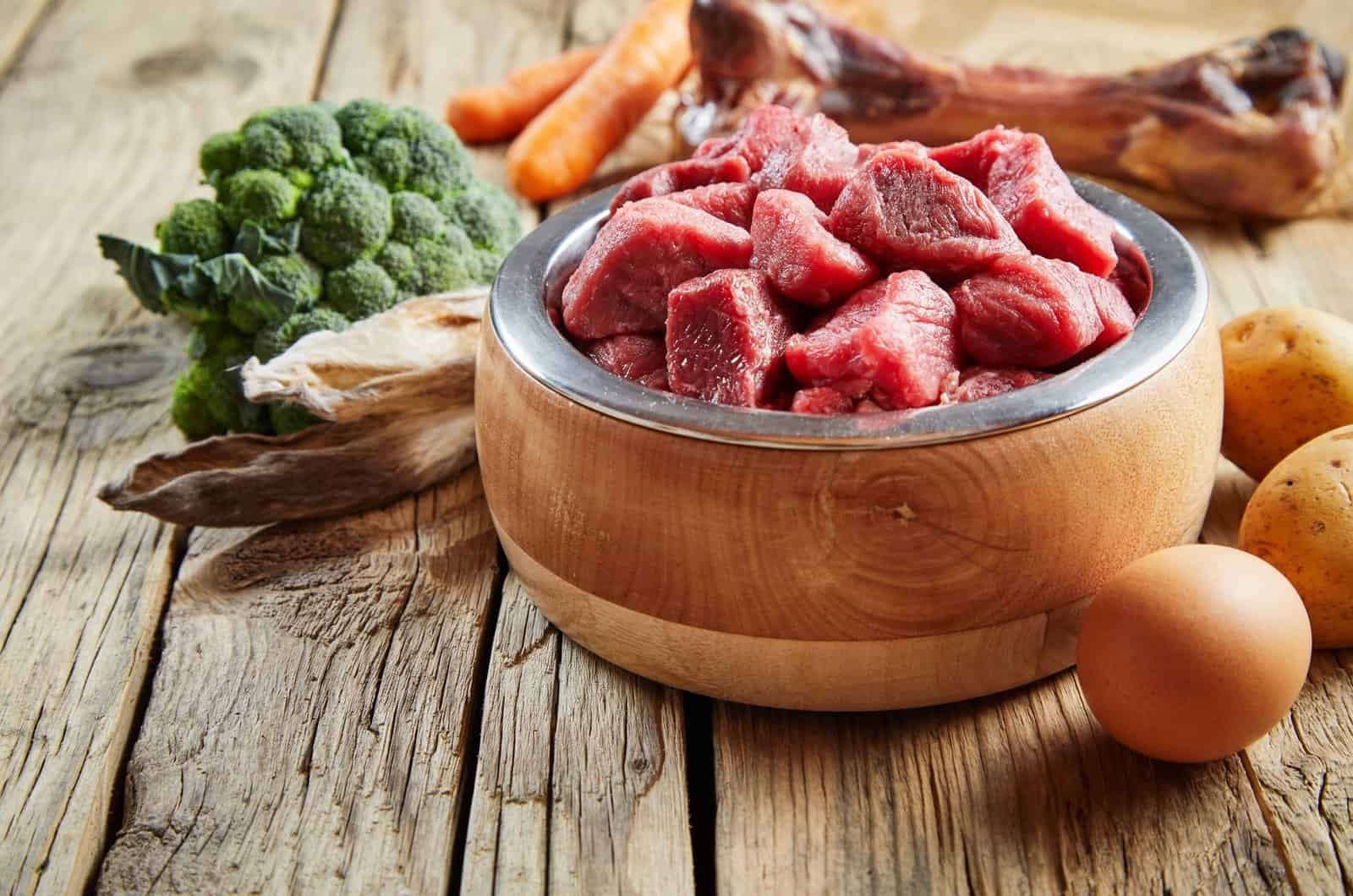
In the last few years, a new trend has emerged in the world of dog diets – the raw food diet has almost become the norm for every dog owner these days.
A raw food diet means that your Shiba Inu puppy will always eat homemade foods that are fresh and don’t contain any preservatives, fillers, or artificial coloring.
In other words, your Shiba Inu won’t be eating store-bought processed food or kibble but will be eating food that you prepare yourself – like a quick and easy boiled chicken meal.
Many Shiba Inu owners prefer a raw food diet over a store-bought food diet because raw food is easier for dogs to digest and it contains fewer carbohydrates, as well as the fact that it greatly lowers the chances of a dog developing inflammatory bowel syndrome.
However, it’s also worth noting that the raw food diet is not without its faults.
Raw foods, such as uncooked meat, contain harmful parasites and bacteria that can lead to severe health issues, many of which can be deadly for your dog.
It’s safe to feed your Shiba Inu puppy raw fruits and veggies that are uncooked but make sure to properly cook any meat in order to get rid of any bacteria and parasites that could harm your pup.
Since the overall safest meat for dogs to consume is chicken, it’s best to do some homework on how to boil chicken for dogs, so that you can avoid parasitic infestation and learn how to properly prepare your pup’s raw food diet.
All in all, it’s always best to talk to a vet before you decide to start feeding your Shiba Inu a raw food diet or give them any additional supplements.
Which Health Problems Are Shiba Inus Prone To?
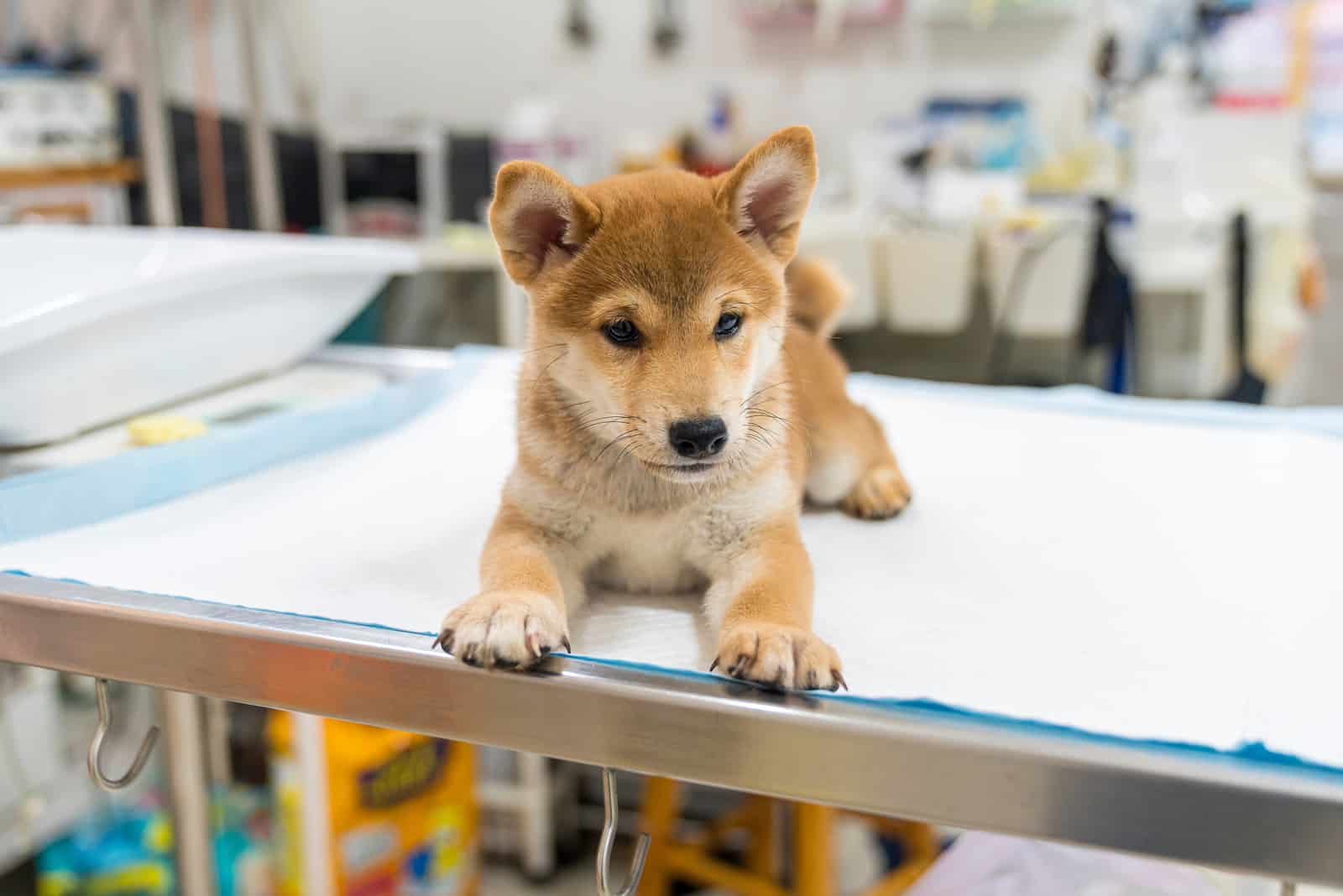
Like any other dog breed, Shiba Inus are prone to developing certain health problems – the easiest way to avoid these is to buy your puppy from the best Shiba Inu breeders that you can find.
Responsible dog breeders will health-test their breeding dogs in order to produce healthy puppies that are free of any hereditary genetic illnesses.
However, if you don’t believe in buying a dog and you would rather adopt, you can always turn to the best Shiba Inu rescues for adoption.
That said, although adopting is admirable and is certainly a cheaper option at first, you can never be certain whether an adopted dog has any hereditary health problems or not.
It’s rare to find a purebred Shiba puppy at a rescue center, most of the dogs that you will find at rescue centers are usually Shiba Inu mixes, which is another way of saying that it’s tough to gauge a dog’s health background – therefore, adopting a rescue dog might lead to more money being spent on vet bills in the long run.
So, here are some of the most common health issues that Shiba Inu dogs are prone to.
Hip Dysplasia
The most common genetic health issue that occurs in the majority of dogs is a musculoskeletal disorder called hip dysplasia – this can be avoided by health testing the parent dogs and can easily be kept in check by feeding your Shiba Inu a high-quality food.
Patellar Luxation
Patellar luxation is a fairly common affliction that’s present in Shiba Inu dogs – if it’s congenital it will be apparent as your puppy ages, it is usually easily noticed at around six weeks of age.
If it’s developmental, it could be caused by any kind of injury to the hind legs of your Shiba Inu, such as a sprain or fracture, which can cause the kneecap to dislocate from the knee joint.
Eye Problems
One of the most common eye problems Shiba Inus face is glaucoma – an extremely painful disease that usually leads quickly to total blindness if left untreated.
The main symptoms of glaucoma are watery eyes, squinting, redness of the eyes, and blurring of the cornea – if you notice any of these symptoms present in your Shiba Inu make sure to take them to the vet as soon as possible.
Another common eye problem that occurs in Shiba Inu dogs is cataracts – they’re the most common cause of blindness in older dogs, including Shiba Inus.
Symptoms of cataracts usually manifest as the eyes appearing cloudy. If you notice your Shiba Inu’s eyes becoming more opaque, make sure to visit your veterinarian in order to determine the next step.
In Conclusion
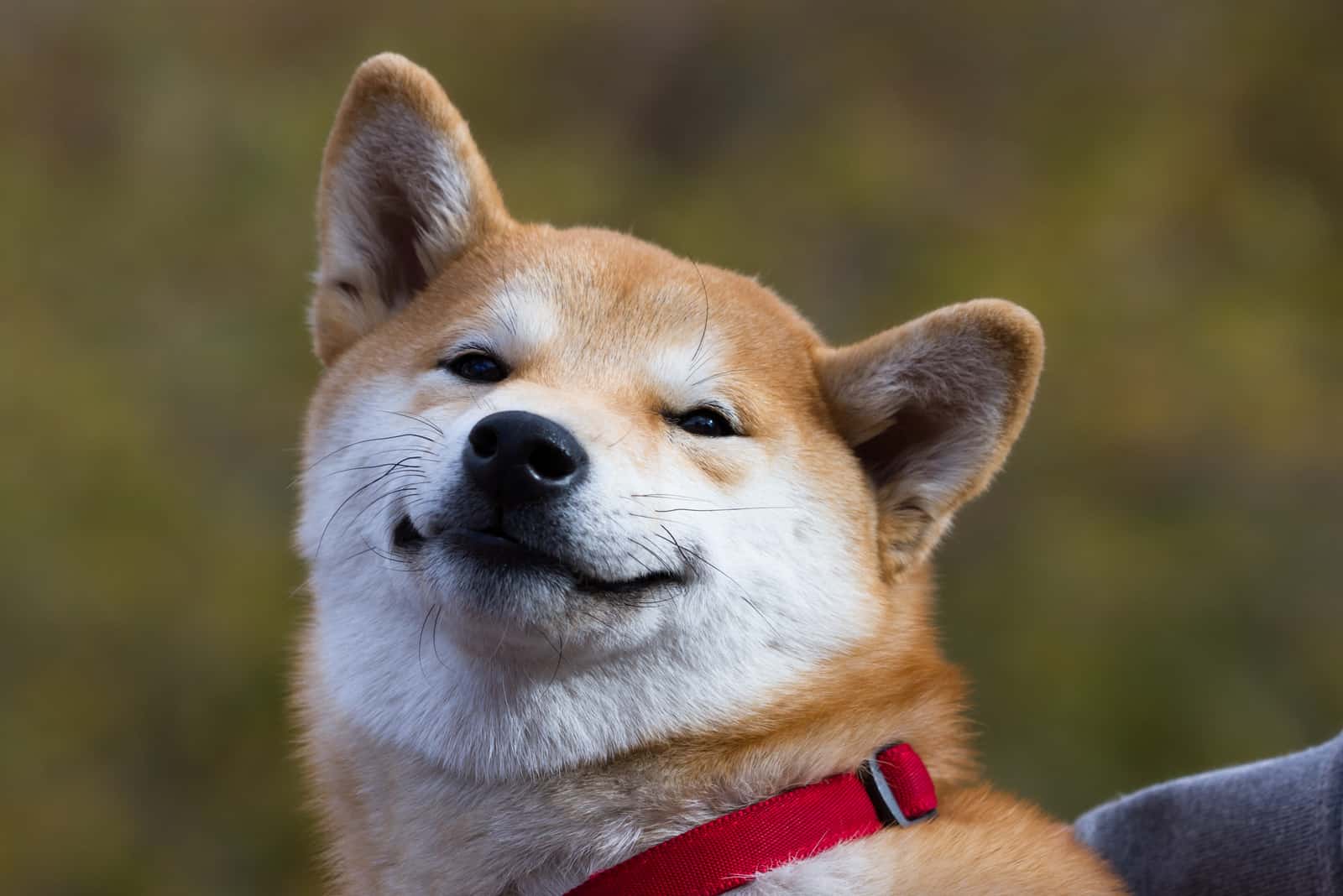
By referring to this Shiba Inu feeding chart you’ll know when and what to feed your Shiba Inu puppy for optimal health results – that said, it’s important to remind you that a feeding chart should only serve as a guideline, not a strict set of rules.
In order to best determine the amount of food and the type of food your Shiba Inu needs, you should take into account all of the factors that affect your puppy’s growth, such as their growth rate, weight, age, food allergies, and overall health.
You also need to keep in mind that Shiba Inus have a faster metabolism than most dogs and that you should adjust their feeding schedule according to their activity level and energy level.
The real key to a Shiba Inu puppy’s proper mental and physical development is a healthy and balanced diet – if your Shiba puppy isn’t eating healthily and exercising enough, the chances are, they might develop certain health issues.
One final thing to remember is to always consult with a vet before you decide to change your Shiba Inus diet or give them any supplements, this will keep your dog as healthy as possible.
Related articles:
• The 6 Best Shiba Inu Breeders In The UK
• The Ultimate Guide To All The Lovely Shiba Inu Colors
